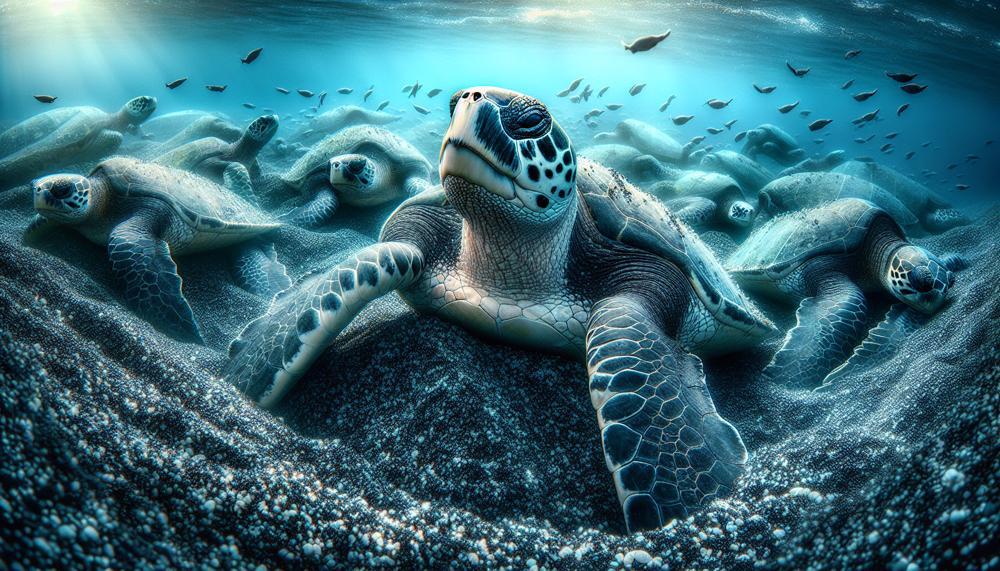Leatherback sea turtles, known for their impressive size, are not just any ordinary turtles. They possess a distinctive living environment that sets them apart from their reptilian counterparts. As we dive into the depths of their underwater home, prepare to be captivated by some intriguing facts about these ancient beings.
- The leatherback sea turtles are truly citizens of the world, found in all tropical and subtropical oceans across the globe.
- Their preferred residence is in open waters, but they can also be spotted near coastlines, coral reefs, and seagrass beds.
- Unlike other turtles, these magnificent creatures do not have a hard shell; instead, they have a leathery skin with seven prominent ridges running along their back.
- With remarkable adaptability, they can withstand extreme temperatures ranging from freezing cold waters to scorching hot beaches.
- The ocean is not only their home but also their supermarket as they feast on jellyfish, squid, and other soft-bodied organisms.
So let us don our diving gear and embark on an unforgettable journey through the enchanting habitat of these marine animals.
Get ready to be mesmerized by the wonders that await us in this magical underwater world.
Contents
- 1 Where Do Leatherback Sea Turtles Live?
- 2 The Migratory Patterns of Leatherback Sea Turtles
- 3 Unique Adaptations for Survival in Different Climates
- 3.1 Insulating layers of fat and a specialized circulatory system:
- 3.2 Extraordinary diving ability:
- 3.3 Countercurrent heat exchange system:
- 3.4 Adaptability to changing temperatures:
- 3.5 Unique Adaptations for Survival in Different Climates:
- 3.6 Fat layers that insulate and a specialized circulatory system:
- 3.7 Incredible diving skills:
- 4 Coastal Areas: Hotspots for Leatherback Sea Turtles
- 5 From Alaska to Africa: Distribution of Leatherback Populations
- 6 Distinct Populations in the Pacific and Atlantic Oceans
- 7 Significant Nesting Sites in South America and the Caribbean Islands
- 8 Conclusion
Where Do Leatherback Sea Turtles Live?

Leatherback sea turtles are widely dispersed throughout tropical and temperate regions, inhabiting coastal waters, lagoons, and open oceans.
These majestic creatures are renowned for their extensive migrations and can be spotted in a diverse range of habitats, including coral reefs, seagrass beds, and sandy beaches.
They have a specific preference for areas with strong ocean currents that provide an abundance of their primary food source, jellyfish.
The geographical locations where leatherback sea turtles can be found span across the Pacific, Atlantic, and Indian Oceans. In the Pacific Ocean, these turtles can be found from the frigid waters of Alaska to the warmer climate of Chile, and from the east coast of Japan to the western coast of Australia.
In the Atlantic Ocean, these magnificent creatures can be found from the chilly waters of Newfoundland to the warmer waters near Argentina, and from Norway to South Africa. In the Indian Ocean, they are found throughout Australia, South Africa, Indonesia, and Madagascar.
Aside from their widespread presence in various oceans, leatherback sea turtles also have specific nesting sites that are crucial to their survival as a species. The majority of these nesting sites can be found in tropical regions such as Trinidad and Tobago, Costa Rica, Malaysia, and Indonesia.
One unique aspect of leatherback sea turtles is their tendency to return to their birthplace when it’s time for them to lay their eggs. This emphasizes the importance of protecting these particular habitats to ensure the continued existence of these magnificent creatures.
The Migratory Patterns of Leatherback Sea Turtles
Ocean currents, temperature, and prey availability all impact the migratory routes of leatherback sea turtles. These creatures are strong swimmers and use the ocean’s currents to their advantage during their journeys. They prefer warm tropical and subtropical waters between 15-30 degrees Celsius and migrate to warmer waters during colder months to maintain their metabolism.
Additionally, leatherbacks primarily feed on jellyfish and migrate to areas with high jellyfish populations. Their reproductive behavior, such as natal homing, also plays a crucial role in determining their movements as they return to the beaches where they were born to lay their eggs.
In addition to these factors, there are other elements that contribute to the complexity of leatherback sea turtle’s migratory patterns. For instance, the location where they were born plays a critical role in determining their movements.
Leatherbacks exhibit natal homing behavior, returning to the same beach where they were hatched to lay their eggs. This behavior helps ensure the survival of the species as it increases genetic diversity and reduces inbreeding.
Unique Adaptations for Survival in Different Climates
The leatherback sea turtle, one of the oldest and largest species of sea turtles, has evolved several unique adaptations to thrive in various climates.
These remarkable adaptations include:
Insulating layers of fat and a specialized circulatory system:
One of the key features that sets the leatherback sea turtle apart is its thick layers of insulating fat and a unique circulatory system.
This enables the turtle to maintain a stable body temperature, even in the coldest of ocean waters.
Extraordinary diving ability:
The leatherback sea turtle has an impressive ability to dive into deep waters, giving it access to food sources that other turtles may not be able to reach.
This gives it an advantage in colder climates where food can be scarce.
Countercurrent heat exchange system:
In addition to its insulating fat layers, the leatherback sea turtle also has a specialized countercurrent heat exchange system in its limbs.
This system helps it survive in deep, frigid waters where other turtles would struggle to withstand the temperature.
Adaptability to changing temperatures:
The leatherback sea turtle has proven to be highly adaptable to changing ocean temperatures.
It can regulate its body temperature by moving to different areas with warmer or cooler waters, ensuring its survival in various climates.
Table:
| Adaptation | Description |
| Insulating layers of fat and specialized circulatory system | Maintains stable body temperature in cold waters |
| Extraordinary diving ability | Provides access to deep water food sources |
| Countercurrent heat exchange system | Aids survival in deep, cold waters |
| Adaptability to changing temperatures | Ability to regulate body temperature in different habitats |
Unique Adaptations for Survival in Different Climates:
The leatherback sea turtle, a species of sea turtle that has been around for centuries and is among the largest, has developed a variety of unique adaptations that allow it to thrive in a wide range of climates.
These exceptional adaptations include:
Fat layers that insulate and a specialized circulatory system:
One of the most notable characteristics of the leatherback sea turtle is its thick layer of fat, along with its specialized circulatory system.
These two features help the turtle maintain a steady body temperature, even when swimming in the coldest of oceans.
Incredible diving skills:
The leatherback sea turtle has an extraordinary ability to dive deep into the ocean, granting it access to food sources that other turtles may not be able to reach.
This is particularly advantageous in colder climates where food can be scarce.
Coastal Areas: Hotspots for Leatherback Sea Turtles
Leatherback sea turtles face numerous challenges in their quest for survival, from climate change and pollution to human interference and habitat destruction. However, these coastal hotspots provide a safe haven for these endangered creatures to thrive and continue their ancient journey.
Take Playa Grande, for example. This stunning beach is home to one of the largest nesting sites for leatherback sea turtles in the world. Here, hundreds of female turtles return year after year to lay their eggs, ensuring the next generation’s survival. And it’s not just about nesting; these hotspots also offer an abundance of food sources for the turtles, from jellyfish and squid to crustaceans and sea grass.
But it’s not just about natural resources; these hotspots also play a crucial role in conservation efforts to protect the leatherback sea turtle species. Organizations like the Sea Turtle Conservancy work tirelessly to monitor nesting grounds, educate local communities about sustainable fishing practices, and rescue injured or stranded turtles.
The importance of these coastal hotspots cannot be overstated; they are not just a sanctuary for leatherback sea turtles but also a symbol of hope and dedication towards preserving our planet’s delicate ecosystems.
From Alaska to Africa: Distribution of Leatherback Populations
Leatherback sea turtles hold the title for being one of the most migratory species on Earth, journeying up to 10,000 miles (16,000 kilometers) in a single trip. Throughout their lifetime, they reside in a diverse range of habitats, spanning all tropical and subtropical oceans across the globe.
They also frequent coastal waters and nesting beaches, showcasing the significance of conservation initiatives to safeguard these majestic creatures and secure their existence in the wild.
From Alaska to Africa: Distribution of Leatherback Populations.
As they migrate through the world’s oceans, leatherback sea turtles can be found in every tropical and subtropical region. Their incredible journeys take them from the frigid waters of Alaska to the warm shores of Africa, with stops in between at various coastal areas and nesting beaches. This widespread distribution highlights the resilience and adaptability of these remarkable creatures.
In Alaska, leatherbacks can be spotted along the northern coastlines during summer months, where they feed on large quantities of jellyfish to fuel their long journeys. As they travel southward, they may encounter different habitats and ocean conditions, but their endurance allows them to thrive in a variety of environments.
In Africa, these magnificent creatures are often found nesting on remote beaches, where they lay their eggs and continue their journey back to sea. These nesting areas are crucial for the survival of leatherbacks as they provide safe havens for their young to hatch and make their way into the ocean.
Overall, leatherback sea turtles’ impressive migrations showcase their adaptability and emphasize the need for conservation efforts to ensure their continued survival.
Distinct Populations in the Pacific and Atlantic Oceans
The unique populations of leatherback sea turtles in the Pacific and Atlantic oceans display various distinctions in their habitats and behaviors. These differences, such as water temperatures, preferred jellyfish species, and nesting patterns, showcase the adaptability and resilience of these magnificent creatures. By gaining a deeper understanding of these distinctions, we can better support conservation efforts for these beloved creatures.
In terms of habitats, Pacific leatherback turtles tend to prefer warmer waters compared to their Atlantic counterparts. This is due to their larger body size and ability to retain heat more efficiently. On the other hand, Atlantic leatherbacks have adapted to cooler waters and are often found in more temperate regions.
Another key difference between the two populations is their preferred jellyfish species. Pacific leatherbacks have a strong preference for the Pelagia jellyfish, while Atlantic leatherbacks favor the Chrysaora jellyfish. This could be attributed to the availability of these species in their respective habitats and the varying nutritional benefits they provide.
Nesting patterns also differ between the two populations. Pacific leatherbacks tend to nest in more isolated areas, while Atlantic leatherbacks favor more densely populated nesting sites. This could be due to competition for nesting sites and food resources in the Pacific, leading to a more spread-out nesting pattern for survival.
Understanding these differences between the distinct populations of leatherback sea turtles allows us to tailor conservation efforts to each group’s specific needs.
By preserving their unique habitats and adapting our conservation strategies to their behaviors, we can ensure the continued survival of these incredible creatures for generations to come.
Significant Nesting Sites in South America and the Caribbean Islands
The conservation and protection of endangered species is a vital responsibility, and some of the most crucial nesting sites for leatherback sea turtles in South America and the Caribbean Islands play a significant role in this effort.
These sites, including Tortuguero National Park in Costa Rica, Shell Beach Protected Area in Guyana, Sandy Point National Wildlife Refuge in the US Virgin Islands, and Matura Beach in Trinidad and Tobago, provide a safe haven for these magnificent creatures.
Tortuguero National Park in Costa Rica boasts the longest stretch of protected beach in the Western Hemisphere. Every year, thousands of leatherback sea turtles journey to this sanctuary to lay their eggs. The park’s pristine conditions and strict regulations ensure that the nesting process is undisturbed, creating an ideal environment for these endangered creatures.
In Guyana, the Shell Beach Protected Area is a designated Ramsar wetland site. Home to four out of the seven species of sea turtles, including leatherbacks, this area is a vital nesting ground for these majestic creatures. The unique ecosystem of Shell Beach provides a diverse range of habitats for various species, making it a crucial location for conservation efforts.
The Sandy Point National Wildlife Refuge in the US Virgin Islands is another critical nesting site for leatherback sea turtles. This refuge is a protected breeding ground with strict regulations in place to ensure their safety. Visitors can participate in guided tours during nesting and hatching season to witness these incredible creatures in their natural habitat.
Lastly, Matura Beach in Trinidad and Tobago is home to the largest leatherback nesting population globally, with over 600 nests recorded in a single season. This beach is a popular tourist destination, offering visitors an opportunity to participate in night patrols and witness the nesting process firsthand.
Also Read: What Do Green Sea Turtles Eat?
Conclusion
In conclusion, the leatherback sea turtle is an extraordinary creature that calls the tropical and subtropical waters of our planet home.
These magnificent animals can be found in open waters, as well as near coastlines, coral reefs, and seagrass beds. With unique adaptations to survive extreme temperatures, they rely on the ocean for their food supply.
From Alaska to Africa, these gentle giants embark on incredible migrations, showcasing their remarkable adaptability and resilience. Coastal areas are crucial for their survival, providing nesting sites and conservation efforts to protect this endangered species.
And let us not forget the critical role that South America and Caribbean Islands play in preserving these ancient beings for future generations.






